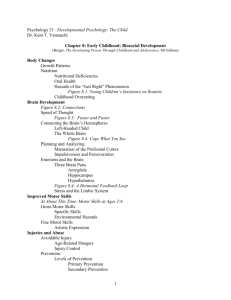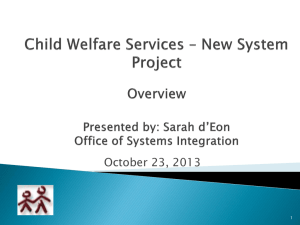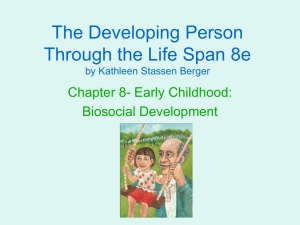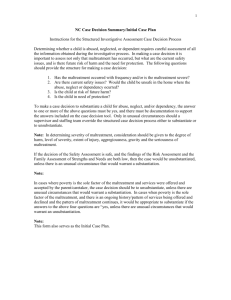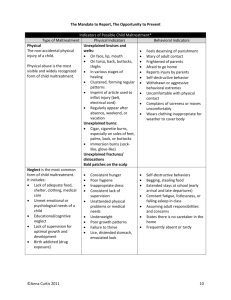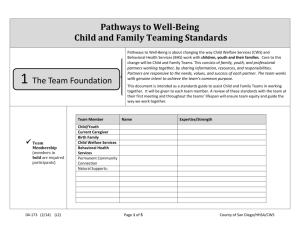9-23-10 Evidence Based Services and Neglect Washington
advertisement
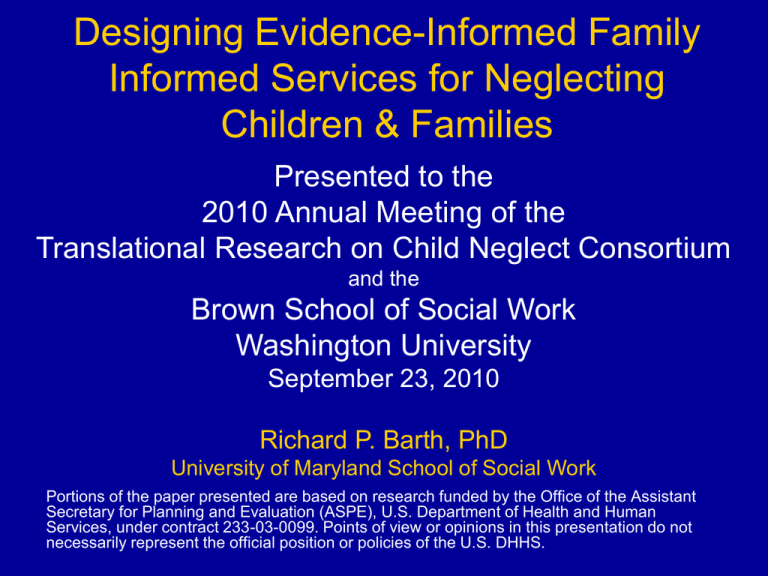
Designing Evidence-Informed Family Informed Services for Neglecting Children & Families Presented to the 2010 Annual Meeting of the Translational Research on Child Neglect Consortium and the Brown School of Social Work Washington University September 23, 2010 Richard P. Barth, PhD University of Maryland School of Social Work Portions of the paper presented are based on research funded by the Office of the Assistant Secretary for Planning and Evaluation (ASPE), U.S. Department of Health and Human Services, under contract 233-03-0099. Points of view or opinions in this presentation do not necessarily represent the official position or policies of the U.S. DHHS. Summary … In Closing 1. It’s time for real-time applications of family information to guide practice – Cumulative family risk is an important one 2. I’ve been wrong—oh so wrong! – My calls for a focus on “Evidence Based Parent Training” have been too narrow • MORE FOCUS NEEDED ON “EVIDENCE-BASED FAMILY WORK” 3. There are some great starts at using family information to guide interventions 2 Efforts toward Interdisciplinary Practice to Prevent Child Neglect 1. Sharing Existing Information in Real Time A. Birth Match (Matching Birth Information and CWS History) B. CAPTA implementation Cross-reporting newborn substance abuse to child welfare services Cross-referring substantiated child abuse reports to Early Intervention Services 2. Gathering Information that is Missing and Putting it Right to Use A. SEEK (A Safe Environment for Every Kid) Family Cumulative Risk as Predictor • Family and Community Risk has turned out to be a highly useful predictor of development (well-being) in NSCAW (and can be generated from routine risk assessment) NSCAW & NEILS Study on CAPTA and Early Intervention Services Integration Half of all infants and toddlers had a low score on a developmental measure Measured Delay = 49% High Risk = 28% (5 or more risk factors but no measured delay) Lower Risk = 23% (< 5 risk factors and no measured delay) 6 The proportion of children with a measured delay who have a substantiated maltreatment report does not differ from children investigated for maltreatment without a substantiated report. 7 Defining Risk 56% have 5 or more risk factors Risk Factor % Maltreatment 100 82% had at least 4 risk factors Poor Parenting Skills 61 Minority Race/Ethnicity 58 Single Caregiver 48 Virtually all had at least 2 risk factors (99%) Poverty 46 Domestic Violence 40 Substance Abuse 39 Caregiver MH Problems 30 Low Caregiver Education 29 Biological/Medical Risk 22 Four or More Children 14 Teenaged Caregiver 19 Maltreatment cooccurs with other problems, placing children at-risk for developmental delay & later school difficulties 8 36 Months After Baseline Compared To 18 Month Follow-up •36 months after baseline only 13% High Risk; 42% Measured Delay, 45% Lower Risk •72% LR remain the same, 22% now with a Measured Delay •Only 28% of HR classified the same, 37% now with Measured Delay Approximately 36 months after Baseline (3-6 years of age) 18 months after Baseline Measured Delay (42%) High Risk (13%) Lower Risk (45%) Measured Delay (50%) 57 10 33 High Risk (29%) 37 28 35 Lower Risk (29%) 22 6 72 (18-54 months in age) Diagonal = Percent unchanged 9 Families Experience Behavior Problems • Despite their young age, young maltreated children have relatively high levels of behavior problems reported by their caregivers— 24% of mothers report a clinical I or E score on CBCL, a proportion that increases from 18-months • Yet support to families is very short term-only 13% of maltreated/substantiated children were still receiving part C services at 36 months 11 Family Focused Services Dwindle by 18- & 36-Months . parent training and • Families are receiving family counseling services through Child Welfare Services or by referral. • These services may have a child development component but are unlikely to be very effective in addressing developmental disadvantages. 12 CAPTA EIS Summary • Based on Measured Delay and/or High Risk, 79% of CWS investigated children were identified as having a measured delay or high risk status • High risk children have an elevated likelihood for poor developmental outcomes, including schoolage problems – Children with more than 5 recognized risk factors at baseline are almost certain to develop measured delays that remain at 36 months 13 Other NSCAW Family Cumulative Risk Findings –NSCAW studies of CWS Decision Making indicate its importance • Family Cumulative Risk Also Has Strong Relationship to Service Decisions –Substantiation –Placement into Foster Care Family Cumulative Risk • NSCAW : Extent of Children’s Mental Health Problems (McCrae & Barth, 2008) – Three clinical measures, the CBCL/YSR,TSCC, and CDI, were combined to create a dichotomous measure of: Clinical Mental Health Problem at Intake (y/n) – Risk Assessment indicators of “family cumulative risk” (21 items) were quite accurate in predicting the measured scores of mental health symptoms (MHS) • Identified 75% of 2 to 6 year olds with MHS • Identified 80% of 7 to 14 year olds with MHS Other Examples of Important Findings of Family Risk and Child Outcomes 16 Adverse Family/Childhood Events Predict Violence as Adolescents 1. Has any adult in your household ever hit you so hard or so often that you had marks or were afraid of that person? (10.4%) 2. Has any older or stronger member of your family ever touched you sexually or had you touch them sexually? (2.6%) 3. Has any adult or other person outside the family ever touched you sexually against your wishes or forced you to touch them sexually? (5.1%) 4. Has alcohol use by any family member repeatedly caused family, health, job, or legal problems? (14.5%) 5. Has drug use by any family member repeatedly caused family, health, job, or legal problems? (10.1%) 6. Has anyone in your family ever hit anyone else in the family so hard or so often that they had marks or were afraid of that person? (11.6%) • 3 or more Yeses, Total = 6.1% (Duke et al., 2010, MN Study) 17 Cumulative Risk & Educational Outcomes in Philadelphia • Odds ratios (Rouse & Fantuzzo, 2009) based on predictions using 1, 2, or 3 family risks (derived from administrative data from homelessness of parent, birth risk, poverty, child maltreatment, low maternal education) and controlling for gender and race • Poor Reading Achievement • Poor Mathematics Achievement • Second Grade Retention 1.28 1.21 1.31 Family-Informed Interventions are Emerging • Birth Match (MI, MD, NYC) • Project SEEK (UMB SOM) • Family Connections (UMB SSW) • Child and Family Center “EcoFit” Programs (U of OR) 19 Birth Match • ASSUMPTION: Children born to parent(s) who have had a previous birth result in the involuntary termination of parental rights (TPR) are at serious risk – EVIDENCE is Indirect • Conditions that result in TPR are often persistent – Substance abuse, maternal depression, unsafe living circumstances (Jonson-Reid et al., 2010) • Newborns are most at risk of death from abuse or neglect Making Very High Risk Births Known to Child Welfare Services (CWS) • History – Under PL 96-272, every child was “entitled” to reasonable efforts to prevent placement • Family history did not (legally) matter – Adoption and SAFE Families Act (1997) • Egregious family history must lead to consideration of “reunification bypass” • Family history matters Making Very High Risk Births Known to Child Welfare Services (CWS) • Birth Match – MICHIGAN: When a parent who has previously had a Termination of Parental Rights gives birth to another child, CWS matches births against TPR database and commences CWS investigation • Policy Presumption that the parent will not continue to care for the child—requires program manager signature to leave newborn in the home • Daily matches • Also now includes violent felons and sexual perpetrators Making Very High Risk Births Known to Child Welfare Services (CWS) • Birth Match – MARYLAND: Department of Health Vital Statistics accepts TPR lists on a weekly basis from DSS and returns matches of children born in the last week who were born to mothers with prior TPRs • A CWS “assessment” is made of the situation – No presumption of any subsequent action • Look back for TPRs is limited to TPRs in the last 5 years Making Very High Risk Births Known to Child Welfare Services (CWS) • NEW YORK CITY – Administrative Policy (not law) – NO BIRTH MATCH – Workers who notice that a mother who has a child in foster care is pregnant, they initiate the investigation – PRESUMPTION: If the home environment is not suitable for a child then it is not suitable for a newborn • Requires Director override to leave newborn in home Using Administrative Data in Real Time • It’s time for researchers and agency leaders to develop real-time advantages from research – Learning what is happening to newborns at the very beginning of life is vitally important WHY ONLY 3 BIRTH MATCH PROGRAMS? – Getting family matches across systems of care is difficult • Health department treats birth information with an exceptional degree of confidentiality • Attorneys believe that CWS assessments are a 25 detriment to their adult clients Project SEEK • Pediatricians working to understand family risks • Referrals to clinic social workers to improve care and reduce child maltreatment “Bright Futures” Developmental Screening Instruments: AAP Endorsed • Ages and Stages Questionnaire • Battelle Developmental Inventory (BDI) Screening Test BUT WHAT’S • Bayley Infant Neurodevelopmental MISSING? Screener (BINS) • Brigance Screens-II • Infant Development Inventory • Child Development Review • Child Development Inventory (CDI) • Denver-II Developmental Screening Test • Parents' Evaluation of Developmental Status (PEDS) What’s Missing in “Bright Futures” Pediatric Screening? • Family (Parent) Well-Being Measures – The future isn’t bright if your parent is suffering • SEEK Parent Screening Questionnaire (PSQ3): Safe Environment for Every Kid SEEK: Easy as 1, 2, 3 … 4 1.Medical residents who received special training (on the importance of family risks for preventing maltreatment, some resources, and motivational interviewing) 2.Parent Screening Questionnaire (SEEK) completed in waiting room 3.Referral to a social worker (1 per every 7 physicians 4.Parent and child (0-5) 29 SEEK Study Design 1118 parents approach, 35% refused or excluded, 23% did not complete protocol. Final 308 (T) and 250 (C) 30 SEEK Items 1. Do you need the phone number for Poison Control? 2. Do you need a smoke detector for your home? 3. Does anyone smoke tobacco at home? 4. In the last year, did you worry that your food would run out before you got money or Food Stamps to buy more? 5. In the last year, did the food you bought just not last and you didn’t have money to get more? 6. Do you often feel your child is difficult to take care of? 7. Do you sometimes find you need to hit or spank your child? SEEK Items (continued) 8. Lately, have you often felt down, depressed, or hopeless? 9. Lately, have you felt very little interest or pleasure in things you used to enjoy? 10.Have you ever been in a relationship in which you were physically hurt or threatened by a partner? 11.Have you ever felt you should cut down on drinking or drug use? 12.Have you ever felt your partner should cut down on drinking or drug use? 13.Are there any other problems you’d like help with today? For more information about SEEK, umm.edu/pediatrics/seek_project.htm SEEK Social Work Procedures • The intervention clinics have a social worker who worked closely with the residents and families • Residents and parents chose whether to involve the social worker • Pediatric management often involved guidance and support in the clinic and referrals to community agencies 33 SEEK: Sample and Results • • • • 93% African American, 87% Single 32% Employed (38% < HS Education) Fewer adults than children in the homes 93% received Medical Assistance MAJOR RESULTS: After onset of the SEEK intervention, there were fewer CPS reports among intervention families (19.2% vs 13.3%; P < .05); 69% of reports were for neglect. 34 Family Connections Core Practice Components 1. Home visiting family intervention 2. Advocacy 3. Service coordination with referrals targeted toward risk and protective factors; and 4. Multi-family supportive and recreational activities. 5. Tailored and direct trauma-informed services to help families reduce risks, maximize protective factors, and achieve service outcomes and goals. 35 Family Connections • Preliminary results from a cross site evaluation by James Bell Associates (JBA) indicate that similar positive changes in risk and protective factors over time were observed in 8 programs replicating FC • Families that were purposefully served for longer (9-12 months) versus shorter (3-6 months) achieved greater improvements in parenting attitudes and child behavior. – Families served by workers who implement FC with a higher degree of fidelity also achieve greater change in family and child level outcomes. 36 8-Site Replication Results So Far • FC holds promise for promoting family well-being by reducing risk factors and increasing protective factors for preventing child neglect • Better outcomes were achieved when the levels of implementation fidelity were higher Filene, Smith & Kass (June, 2010). Presentation to Society for Prevention 37 Research, Denver. Family Check Up 38 Family Check Up • The intervention services are family centered • They address and support parents of children and adolescents in the change process. • They focus on supporting parents’ leadership role in their children’s lives. • The intervention services are family assessment driven • Decisions about how to tailor interventions to individual and family needs are based on careful assessments of the child and family at home and the child in school. 39 Family Check Up • Lessons Learned from Family Check Up – To prevent child behavior problems there may be a need to intervene early and directly with: • (a) the emotional climate of the family and • (b) the emotional climate of the parenting relationship. • These facets of child and family dynamics are highly interrelated and often need to be addressed together 40 Prevention of Child Abuse Occurrence, Recurrence, & Impairment Must be Family Focused FAMILY FOCUS NFP, Early Start (NZ), Triple P (AUS) Source: MacMillan et al. (2009). Lancet 41 Family Data: Waste Not, Want Not We waste untold amounts of family data • Birth data is overprotected and underused • (Nearly) every state collects risk assessment data and then fails to put it into play with administrative data • Every state collects family based foster care and adoption licensing and home study data but fails to use that information to understand placement outcomes • Every state collects TANF addresses and adoption subsidy data and address payment data for families but fails to keep track of when subsidy change requests are frequent or address changes are frequent—perhaps signaling family instability Opportunism and Incrementalism • Gregg Bloche (2007) and Janet Bronstein (2008), writing about health care, have argued that system reform is most likely to arise in an incremental manner from existing institutional arrangements. • They assert that we should be opportunists, keeping our eyes open for examples of local changes and established local arrangements to improve the quality of care. 43 Opportunism and Incrementalism • So, what can we learn from this approach of examining local developments? • To try and test a variety of ways to achieve work with “Family Data”: – birth records, administrative children’s services and health records, measurement feedback systems, brief assessments, co-located services, and family centered case management reimbursement mechanisms – You can think of more 44 The Grass Isn’t Greener on the “other side” or on “your side” -- it’s greener where you water it… We have to more thoroughly water family assessment and data integration if we will be powerful interventionists 45 Thank You Very Much Additional Questions or Comments? 46 Partial References Berrick, J. D., Choi, Y., D'Andrade, A., & Frame, L. (2008). Reasonable Efforts? Implementation of the Reunification Bypass Provision of ASFA. [Article]. Child Welfare, 87(3), 163-182. Bloche, M. G. (2007). A graveyard for grand theory. [Article]. Health Affairs, 26(6), 1534-1536. doi: 10.1377/hlthaff.26.6.1534 Bronstein, J. M. (2008). Policy levers that improve low income children's access to mental health services. [Editorial Material]. Medical Care, 46(6), 555-557. Chambers, R. M., & Potter, C. C. (2009). Family Needs in Child Neglect Cases: A Cluster Analysis. [Article]. Families in Society-the Journal of Contemporary Social Services, 90(1), 18-27. doi: 10.1606/1044-3894.3841. DePanfilis, D., Dubowitz, H., & Kunz, J. (2008). Assessing the cost-effectiveness of Family Connections. Child Abuse & Neglect, 32(3), 335-351. Dubowitz, H., Feigelman, S., Lane, W., & Kim, J. (2009). Pediatric Primary Care to Help Prevent Child Maltreatment: The Safe Environment for Every Kid (SEEK) Model. [Article]. Pediatrics, 123(3), 858-864. doi: 10.1542/peds.2008-1376. Duke, N. N., Pettingell, S. L., McMorris, B. J., & Borowsky, I. W. (2010). adolescent violence perpetration: associations with multiple types of adverse childhood experiences. [Article]. Pediatrics, 125(4), E778-E786. doi: 10.1542/peds.2009-0597. Filene, JH, Smith, E. G, & Kass, L. (2010). Implementation of an evidence-based child neglect prevention program: findings from a multi-site replication of Family Connections. Presented at the Society for Prevention Research, Denver, CO, June 3, 2010. Gonzalez, A., & MacMillan, H. L. (2008). Preventing child maltreatment: An evidence-based 47 update. [Article]. Journal of Postgraduate Medicine, 54(4), 280-286. References Jonson-Reid, M., Chung, S., Way, I., & Jolley, J. (2010). Understanding service use and victim patterns associated with re-reports of alleged maltreatment perpetrators. [Article]. Children and Youth Services Review, 32(6), 790-797. doi: 10.1016/j.childyouth.2010.01.013. Linville D, Chronister K, Dishion T, et al. A Longitudinal Analysis of Parenting Practices, Couple Satisfaction, and Child Behavior Problems. Journal of Marital & Family Therapy [serial online]. April 2010;36(2):244-255. Available from: SocINDEX with Full Text, Ipswich, MA. Accessed September 9, 2010. MacMillan, H. L., Wathen, C. N., Barlow, J., Fergusson, D. M., Leventhal, J. M., & Taussig, H. N. (2009). Child Maltreatment 3 Interventions to prevent child maltreatment and associated impairment. [Article]. Lancet, 373(9659), 250-266. Manning, M., Homel, R., & Smith, C. (2010). A meta-analysis of the effects of early developmental prevention programs in at-risk populations on non-health outcomes in adolescence. [Article]. Children and Youth Services Review, 32(4), 506-519. doi: 10.1016/j.childyouth.2009.11.003. McCrae, J. S., & Barth, R. P. (2008). Using cumulative risk to screen for mental health problems in child welfare. [Article]. Research on Social Work Practice, 18(2), 144-159. doi: 10.1177/1049731507305394. Rouse, H. L., & Fantuzzo, J. W. (2009). Multiple risks and educational well being: A populationbased investigation of threats to early school success. [Article]. Early Childhood Research Quarterly, 24(1), 1-14. doi: 10.1016/j.ecresq.2008.12.001 Williams, J. H., Van Dorn, R. A., Bright, C. L., Jonson-Reid, M., & Nebbitt, V. E. (2010). Child 48 Maltreatment and Delinquency Onset Among African American Adolescent Males. [Article]. Research on Social Work Practice, 20(3), 253-259. doi: 10.1177/1049731509347865
